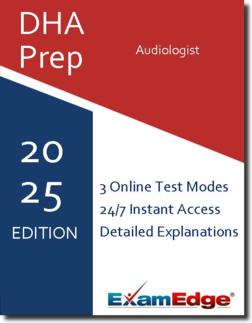DHA Audiologist Practice Tests & Test Prep by Exam Edge - Topics
Based on 37 Reviews
- Real Exam Simulation: Timed questions and matching content build comfort for your DHA Audiologist test day.
- Instant, 24/7 Access: Web-based DHA Audiologist practice exams with no software needed.
- Clear Explanations: Step-by-step answers and explanations for your DHA exam to strengthen understanding.
- Boosted Confidence: Reduces anxiety and improves test-taking skills to ace your DHA Audiologist (AUDIO).

Understanding the exact breakdown of the DHA Audiologist test will help you know what to expect and how to most effectively prepare. The DHA Audiologist has 100 multiple-choice questions The exam will be broken down into the sections below:
| DHA Audiologist Exam Blueprint | ||
|---|---|---|
| Domain Name | ||
| Ethics and Professionalism | ||
| Infection Control | ||
| Anatomy and Physiology | ||
| Physics of Sound | ||
| Instrumentation | ||
| Pediatrics | ||
| Adults and Older Adults | ||
| Auditory Evoked Potentials | ||
| Vestibular/Balance | ||
| Disorders and Syndromes | ||
| Hearing Aids and implantable Hearing Devices | ||
| Documentation and Communication / Counseling |


